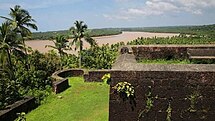Kasaragod District
| |
|---|---|
|
Clockwise from top: Ranipuram, Bekal Fort, Bekal beach, Chandragiri fort, Kavvayi Backwaters at Nileshwaram, Chandragiri River at Kanathur near Kasaragod | |
| Nickname: The Land of Seven Languages[1] | |
 Location in Kerala | |
| Coordinates: 12°30′N 75°00′E / 12.5°N 75°E | |
| Country | |
| State | Kerala |
| Established | 24 May 1984 |
| Founded by | Government of Kerala |
| Headquarters | Kasaragod |
| Subdistricts | |
| Government | |
| • District Collector | K Inbasekar IAS |
| • Superintendent of Police | Bijoy P IPS |
| • MP | Rajmohan Unnithan (INC) |
| Area | |
• Total | 1,992 km2 (769 sq mi) |
| • Rank | 13th |
| Population (2018)[2] | |
• Total | 1,390,894 |
| • Density | 698/km2 (1,810/sq mi) |
| Demographics | |
| • Language (2011) | |
| • Religion (2011) |
|
| Human Development | |
| • Sex ratio (2011) | 1080 ♀/1000 ♂[5] |
| • Literacy (2011) | 90.09%[6] |
| Time zone | UTC+5:30 (IST) |
| PIN | 671121 |
| Telephone code | 0499 |
| ISO 3166 code | IN-KL |
| Vehicle registration | KL-14, KL-60, KL-79 |
| HDI (2005) | |
|
|
| Website | kasargod |
Kasaragod (Malayalam: [kaːsɐrɡoːɖɨ̆] (Tulu: Kāsrōḍ, Kannada: Kāsaragūḍu, Marathi: Kāsāragōḍa; English: Kassergode) is one of the 14 districts in the southern Indian state of Kerala. Its northern border Thalappady is located just 9 km south to Ullal, which is the southernmost portion of the major port city Mangalore, on the southwestern Malabar coast of India.
Kasaragod is the northernmost district of Kerala and is also known as Saptha Bhasha Sangama Bhoomi (The place where Seven languages meets)
The district is situated on the rich biodiversity of the Western Ghats. It was a part of the Kannur district of Kerala until 24 May 1984. It also remains the last formed district of kerala to date. The district is bounded by Dakshina Kannada district to the north, Western Ghats to the northeast, Kodagu district to the southeast, Kannur district to the south, and the Arabian Sea to the west. Kasaragod district has the maximum number of rivers in Kerala - 12.[9]
Kasaragod town is located on the estuary where the Chandragiri River, which is also the longest river in the district, empties into Arabian Sea. Kasaragod is home to several forts which include Arikady fort, Bekal Fort, Chandragiri Fort, and Hosdurg Fort. Bekal Fort is also the largest fort in Kerala. The historic hill of Ezhimala is located on the southern portion of Kavvayi Backwaters of Nileshwaram. Talakaveri, which is home to Talakaveri Wildlife Sanctuary where the 805 km long Kaveri River originates, is located closer to Ranipuram in Kerala-Karnataka border. Robert Caldwell describes the extent of Malayalam in the late 19th century as extending from Chandragiri fort and Chandragiri river in the north to Neyyar river beyond Thiruvananthapuram in the south.[10]
Tulunad, where Tulu is traditionally spoken, is said to be bound on the south by the Chandragiri river and fort, thus including Kasaragod city within the Tulunad region.[11] Historian N. Shyam Bhat states that at present, the Tulu nadu can linguistically be said to extend to the south up to the river Chandragiri or Payaswini, and culturally up to the Kavvayi river in the south, as the region between the Chandragiri and Kavai (Kavvayi) rivers presents the characteristics of a twilight zone between the Malayalam and Tulu speaking areas.[12]
Kasargod is also the first district in India to have official symbols-official tree, flower, bird, species. [8]
- ^ "Kasargod - the land of seven languages". invest kerala. Government of Kerala. Retrieved 12 September 2020.
- ^ Annual Vital Statistics Report - 2018 (PDF). Thiruvananthapuram: Department of Economics and Statistics, Government of Kerala. 2020. p. 55. Archived from the original (PDF) on 2 November 2021. Retrieved 29 October 2020.
- ^ Cite error: The named reference
languageswas invoked but never defined (see the help page). - ^ "Table C-01: Population by religious community: Kerala". Census of India. Registrar General and Census Commissioner of India. 2011.
- ^ "Sex Ratio" (PDF). censusindia.gov.in.
- ^ "Literacy" (PDF). censusindia.gov.in.
- ^ "Kerala | UNDP in India". UNDP.
- ^ a b Bureau, The Hindu (20 October 2023). "Kasaragod becomes first district in India to declare official tree, flower, bird, species". The Hindu. ISSN 0971-751X. Retrieved 29 October 2023.
{{cite news}}:|last=has generic name (help) - ^ "Rivers in Kasargod". Kerala Tourism. Retrieved 12 September 2020.
- ^ Caldwell, Robert (1998). A Comparative Grammar of the Dravidian Or South-Indian Family of Languages. Asian Educational Services. pp. 16, 17–19, 20, 21–25. ISBN 978-81-206-0117-8.
- ^ Steever, Sanford B. (15 April 2015). The Dravidian Languages. Taylor & Francis. pp. 158–159. ISBN 9781136911644.
- ^ Bhat, N. Shyam (1998). South Kanara, 1799-1860, A Study in Colonial Administration and Regional Response. Mittal Publications. p. 6. ISBN 9788170995869.






